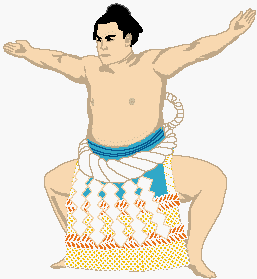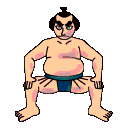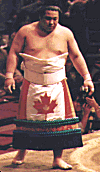

Wrestling is a popular sport that dates back many thousands of years.
Sumo wrestling is not only the oldest of Japan’s various martial arts, it also evolved into the most distinct and ritualistic. It is still heavily centered around the Shinto religion. When the sport was first introduced 1500 years ago it was performed mostly to ensure good harvests.
Sumo wrestling's popularity quickly spread, becoming a more public and widespread event. Matches were usually brutal, the loser often expected to forfeit his life. By the 7th century Sumo had fallen under the protection of the warring Shogunite regime and was largely banned as a public spectacle. Only the samurai, or warrior class, were allowed to practice it as part of their military training.

Once peace was finally restored Sumo once again fell under the backing of the Japanese royal courts and was dubbed the Imperial sport. By the 15th century Sumo wrestling had adopted a set of strict rules and the most talented champions were offered aid by powerful feudal lords. In the early 1700’s “banzuke” or ranking lists, were established, a system which is still strictly adhered to today. The objective of the “sumotori”, or competitors, many of whom weigh between 250 and 500 pounds, is to either knock his opponent from a specially-sized ring or maneuver him so that any part of his body touches the ground. This is done by using one or a series of 70 accepted Sumo moves, some of which are pushing, slapping, hoisting, tripping, pinning or throwing. Six 15 day tournaments are held each year in Japan in the cities of Tokyo, Osaka, Nagoya and Fukuoka.
![]()
Sumo matches are fought in a “dohyo”, a raised and sanctified platform constructed with clay and sand and onto which a 14 foot 10 inch circle is marked out using half buried straw bales. Suspended above the ring is a wooden structure that resembles the roof of Shinto shrine. Each Sumo tournament begins with much pageantry and ceremony. The wrestlers, the referees, and the various attendants and helpers wear colourful attire, the design of which remains steeped in ancient traditions and meanings dating back to Japan’s Edo period. The grand champions, all wearing intricately embroidered silk aprons some of which are worth in excess of 500,000 yen, enter the ring first and begin their own elaborate rituals called “doyho-iri”. After gathering in a circle, clapping hands and performing lengthy and ritualistic postulating, they leave the ring, making way for the other lower-ranked sumatori who then carry out the same ritual.

There is no weight class in Sumo wrestling so very often the “Rikishi”, or competitors, find themselves squaring off against a much heftier opponent. The match begins when two Rikishi enter the ring, now stripped to nothing but their traditional loin cloth, or “Mawashi”, a belt that when unwrapped can stretch to 30 feet. Next the “chiri-chozu” ceremony is performed. Both men squat at opposite ends of the ring, extend their arms, then clap their hands once. The wrestlers move on to perform the “Shiko,” an exaggerated foot stamping ritual after which each man reaches into a basket of unrefined salt and tosses it to purify the ring.
Now the match is almost ready to start; each man strides to a marked white line, crouches down, clenches his fists, then proceeds to glare in the hopes of breaking the other’s focus. These glare-offs are timed and may not extend past 4 minutes. At any time during the 4 minute countdown, the Rikishi may lunge at each other and begin grabbing each other. Hair pulling, punching with the fists, gouging around the eyes and kicking vital areas are strictly prohibited. Often a match lasts mere seconds before the more powerful or agile opponent executes a deft move and tosses, pushes, slaps or in some other way disqualifies his rival.
A Sumo wrestler’s ranking depends solely on the number of matches he wins during official tournaments. Even a grand champion may fall from the top ranks if, during the course of these tournaments, his losses outnumber his wins. Twenty awards are divided amongst the competitors of the six different Sumo divisions, the most prestigious being the Emperor’s Cup. The goal of every Sumo wrestler is to have his name engraved on the cup and his life-sized portrait displayed for the masses. One of Japan’s most popular Sumo wrestlers, Chiyonofuji, has won the Emperor’s Cup no less than 27 times.

The training regimen for Sumo wrestlers is strict and rigorous and is generally supervised by retired Rikishi. There are numerous Sumo schools in Japan and young recruits usually enter as teenagers. Each youth must pass a weight class before acceptance. The schools teach rules, etiquette, basic techniques and the history of Sumo. Scouts from various “stables” , or Sumo training centers, visit schools to recruit promising students who they hope might become the next stars of the Sumo ring. Once a young man enters a stable he must be totally committed to the years of training required to become an accomplished rikishi.
![]()
Even within a Sumo stable there is a specific and strictly enforced ranking. The youngest recruits are often required to rise as early as 4 AM to train and are expected to act as assistants or to wait on the older rikishi during mealtimes. All meals are prepared using high protein foods for optimum weight gain. For centuries it was believed that the larger the wrestler’s girth, the greater his chance of becoming a grand champion. However, health problems have plagued Sumo wrestlers for decades. Many ailments are a direct result of rapid and excessive weight gain. In an effort to produce healthier fighters various stables no longer practice force feeding. Others have also adopted weight training and other forms of exercise to create slimmer, yet equally powerful wrestlers.
![]()
The Sumo Association of Japan is the foremost governing body of Sumo wrestling and consists of retired or “elder” rikishi. Besides overseeing tournaments and other events, the Association also divides allowances amongst the 40 established Sumo stables across Japan. Additional sponsorship from wealthy businessmen and the general public is also encouraged.
![]()
Despite Sumo wrestling archaic ritual and tradition, the sport continues to draw new fans and growing international interest. Hundreds of Sumo wrestlers of various nationalities earn comfortable livelihoods, participating in matches not only in Japan, but in Europe, North America and Britain. Grand champions attain celebrity status and garner much adulation from dedicated fans. Women are even stepping into the squared Sumo circle. In 1997 Japan held its first ever Sumo championship for women. How far these grappling ladies will progress in what has for centuries been a male-dominated contact sport remains to be seen.
Read more on 